Kazakhstan
October 29th-31st.
By Dan Murdoch
THERE was a little trouble trying to get out of Kyrgyzstan. We had forgotten to collect customs papers for the cars when we entered the country. No one at the border had said we needed any, and there was no obvious place to get them, but apparently we should have asked for them and of course they were needed on exit.
The problem was far from trivial- the first solution a friendly but initially unyielding official suggested was returning to our point of entry to get the papers. Back across Kyrgyzstan? Across the mountains?
Out of the question.
After some negotiations we found we could get new papers in Bishkek, but would have to pay a fine based on engine size.
Seeing as we are driving 600cc lawn mowers across the world, this wouldn’t be a big financial penalty. But it would cost us another few days.
Finally we played our charity card, explained our mission and showed them some photos of us with kids at a Kyrgyz NGO. A local, who was acting as translator, was won over by the cause and negotiated our release.
At the Kazakh border we remembered to ask for customs papers.
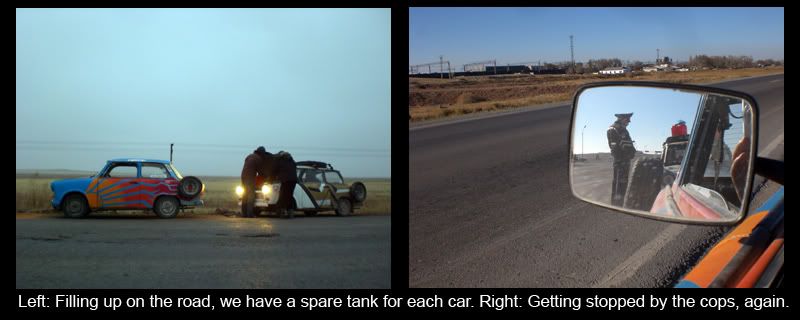
It was great to be back behind the wheel of Fez. It felt like a new beginning:
Chapter Two- the drive north through Kazakhstan, across Siberia and into Mongolia, before the long road south, through China and South East Asia, all the way to the Gulf of Thailand.
Carlos is my new driving buddy, replacing Megan, who left a few weeks ago.
The Spaniard is also known as Les (his Catalan name is Carles), AKA The Lesbian, or Los (his Spanish name is Carlos) AKA The Losbian, or The Gay (his surname is Gey), or sometimes Spanish or Pedro.
We drove together for a few weeks at the beginning of the trip, then he spent quite a lot of time driving with OJ. As the two male members of Team Europe, we spent most of last month exploring Bishkek, and get on well, have shared stories and jokes and I have ignited a passion for The Mighty Boosh in the Spaniard.
Despite the backwards portrayal of Sacha Baron Cohen’s pseudo-Kazakh, Borat, Kazakhstan is actually the largest, richest, and most developed of the Central Asian countries.
Abundant oil and gas deposits mean there is plenty of money floating about in the cities, although there is also some pretty extreme poverty, particularly in the countryside.
Under the Soviets the vast, empty country was something of a dumping ground. It was used for nuclear testing (huge swathes of land are now uninhabitable), home to gulags and forced labour camps. Dissidents, such as the author Dostoevsky, were banished here, and Stalin sent whole races of people out here to work.
The nation’s president has been in charge since the Soviet collapse in 1991, when Kazakhstan suddenly gained independence and a nuclear arsenal, and the progressive, reformist leader probably wont voluntarily relinquish control. Democracy is practised in name with regular elections, although none have been deemed free or fair by international watchdogs. But the president has overseen the overhaul and expansion of the country’s economy and built a new capital, Astana, to mark his nation’s emergence as a regional economic power.
Although we wouldn’t be visiting any of the cities to see any of these changes, it was nice to be back in a country where the petrol stations sell drinks and chocolate. It’s not a big detail, but it makes a difference to life on the road.
In a cloudless blue sky the distance is slowly filled by a low gathering of pinkish cotton candy. It rests low on the horizon, as if we are high in the mountains, flirting with the clouds, not driving through the low in plains. When we get close enough I realise the thick smog is coming from an industrial city with multiple chimneys spewing a tower of smoke high into the air that then cools and settles over the area like a toxic halo. As the sun dips low behind us, its rays slow in our atmosphere and the reds of the solar spectrum pick out the cloud in a frightening pink. I think the city was called Balkhash.
As we left we followed a line of enormous piles of burning rubbish, dumped in the fields and set alight.
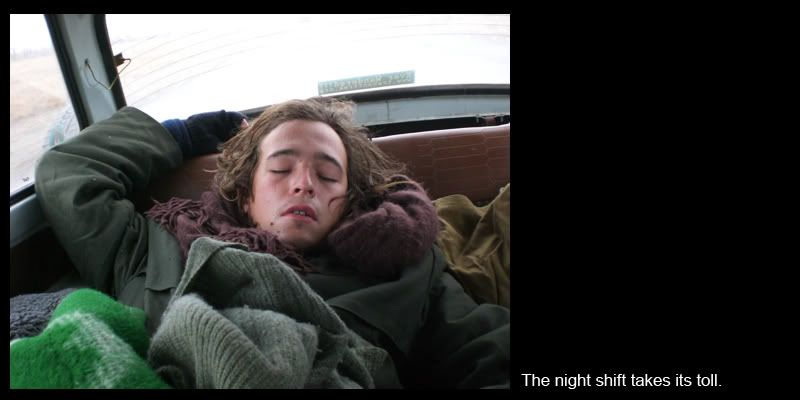
Over dinner at a roadside café, we decided that it would be best to rush through Kazakhstan as quickly as possible. Time wasn’t on our side and we hadn’t heard too many great things about the cities on our route. So we resolved to try and drive in shifts, non-stop.
That plan was messed up when, shortly after 4am, Dante’s front left wheel inexplicably shot off. I was asleep at the time so I asked Carlos what had happened.
“It was a cold and dark night and the moon was shining,” he told me, I think he knew I was taking notes, “you could hear the whisper of the cold telling you you were going to die.” He paused for dramatic affect, and stifled a laugh.
“Suddenly I saw all these sparks coming from Dante. They pulled over and I saw the wheel was missing. So I pulled up to them, Tony just looked at me out the window, he didn’t say anything, it was priceless.”
We drove around a bit looking for the renegade wheel, but it was too dark in the cratered steppe. Tony said he had seen it roll off into the night: “It went that way,” he pointed in a vague arc.
“How fast were you going?” I asked.
“About 70.”
“So the wheel went that way,” I swept my arm over the dark horizon, “at 70kph?”
“Yeah.”
We decided to camp for the night and have another look in the morning.
At night Carlos and I turn our little Trabbi into The Fez Hilton. There is no passenger seat and the driver’s seat is removable, so with a little rearrangement we have two fully reclined beds. Everyone has heaps of warm weather gear now, and the blankets, duvets, sleeping bags and cushions aid the most comfortable car sleep I have had.
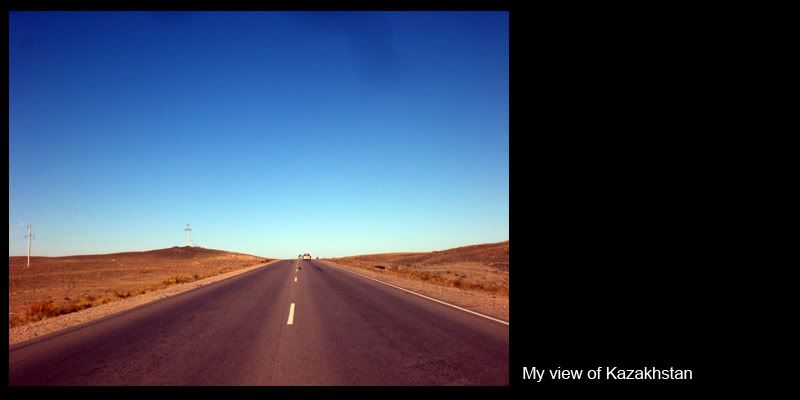
My sleeping pattern was all screwed up by the malaise of Bishkek, so it made sense for me to do the late driving shift. I regret it because it meant that I really saw little of Kazakhstan other than the dimly lit arc of Fez’s headlights on tarmac, and the rear end of Ziggy.
We didn’t find the wheel that morning, but I got my only really decent look at the famous Kazakh steppe- the huge, arid plain that dominates this latitude of Asia. The soil is sandy, but punctuated by hardy shrubs and gorse. It stretches out for hundreds of miles, undulating but not rolling, with little that could be called a hill, and no trees. The soil wont take agriculture, so settling is not really an option, and there is little for cattle to eat. It is no wonder the plains have been home to the world’s great horseman over the years- the nomads had little choice but to wander around on their mounts looking for a meal. Out of this barren flatness successive mounted hordes have emerged to rape and pillage Europe’s eastern frontier, Scythians, Huns, Mongols, but they left no major marks on this huge, hostile territory.
We raced through Kazakhstan. I did a shift from 5pm to 5am, pretty terrible driving hours. But my sleeping pattern is truly abysmal and I had slept all day so fatigue wasn’t a problem.
For a few hours the steppe was swathed in a thick mist. Doing 80kph in darkness on these bumpy roads in a rattling, vibrating Trabbi feels like driving a rocket. In the fog it felt like flying a MIG through a turbulent cloud, we could have been doing 200mph, not 50.
We crossed Central Asia’s largest country, the ninth biggest in the world, in 44 hours. More than 1,500km. At 80kph. A Trabant Trek record. Very proud of that one.
On the 31st, after 30 hours of straight driving, we left the country, and the ‘stans, behind.
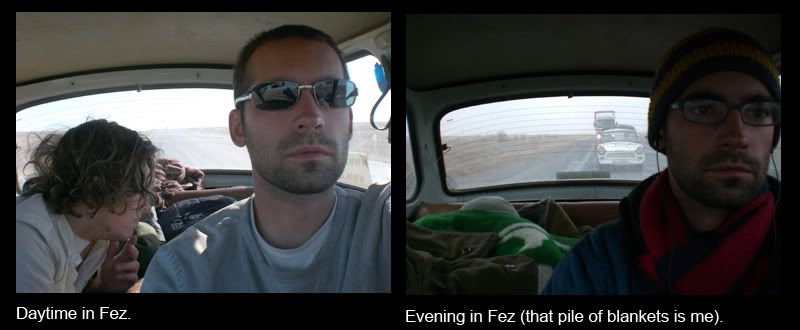
Central Asia was bad for us.
We lost a car, two people, two roof racks, thousands of dollars, vast quantities of spare parts and roughly a month. We gained an intricate knowledge of the region’s visa system, particularly the American’s, who now have two sets of Turkmen, Tajik, Kyrgyz, Kazakh and Russian visas. I could take you a tour of Bishkek’s bars and eateries. I now have the street equivalent of a PhD in Traffic Cop Psychology.
It is hard now, just a few days after leaving, to sum up my thoughts on the region. We had such varied experiences: A month in urban, Russified Bishkek versus a fortnight stuck in the remote Tajik mountains; staying in renovated, historic Khiva versus camping on the dusty Turkmen-Uzbek border; the long straight roads of Kazakhstan versus the rock strewn mud track of the Anzob Pass.
It is hard to weigh it all up. In Turkmenistan, Uzbekistan and Tajikistan the police interference was regular, we were stopped constantly and unnecessarily although we were rarely bribed. In Bishkek I wish there were more police, I didn’t feel safe at night.
There is no doubt it was the most difficult part of the trek so far. A combination of the poor roads causing breakdowns and delays, and the bureaucracy involved in getting new visas made it a testing time. But once we dumped the Merc the roads were less of a problem, and the visa problems followed on from the breakdowns.
I would go back. I would like to see more of Uzbekistan’s Silk Road cities. I would recommend the Darvaza gas crater in Turkmenistan to anyone, and Tajikistan’s Pamir Mountains were probably the most stunning drive yet.
But I'm not sure I would take a Trabant.
Ends
mrdanmurdoch@gmail.com
For more of Dan’s blogs visit: danmurdoch.blogspot.com or www.trabanttrek.org

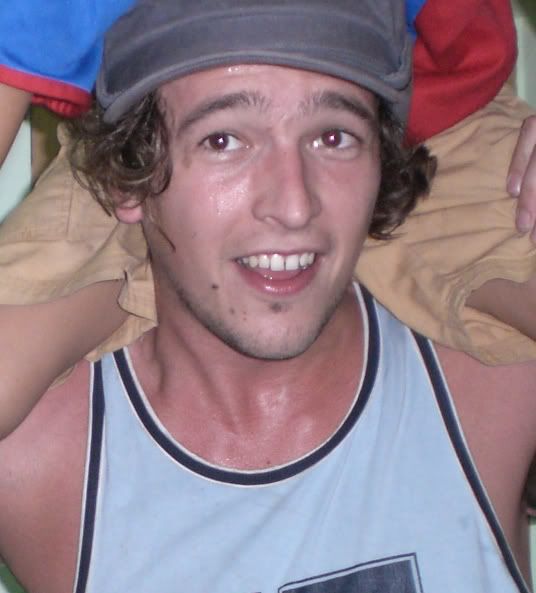
No comments:
Post a Comment